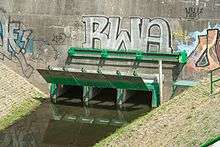Culvert
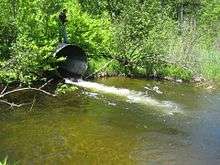
A culvert is a structure that allows water to flow under a road, railroad, trail, or similar obstruction from one side to the other side. Typically embedded so as to be surrounded by soil, a culvert may be made from a pipe, reinforced concrete or other material. In the United Kingdom, the word can also be used for a longer artificially buried watercourse.[1]
Culverts are commonly used both as cross-drains for ditch relief, and to pass water under a road at natural drainage and stream crossings. A culvert may be a bridge-like structure designed to allow vehicle or pedestrian traffic to cross over the waterway while allowing adequate passage for the water.
Culverts come in many sizes and shapes including round, elliptical, flat-bottomed, pear-shaped, and box-like constructions. The culvert type and shape selection is based on a number of factors including requirements for hydraulic performance, limitations on upstream water surface elevation, and roadway embankment height.[2]
If the span of crossing is greater than 12 feet (3.7 m), then the structure is termed a bridge. A structure that carries water above land is known as an aqueduct.
The process of removing culverts, which is becoming increasingly prevalent, is known as daylighting. In the UK, the practice is also known as deculverting.[3]
Materials
Culverts can be constructed of a variety of materials including cast-in-place or precast concrete (reinforced or non-reinforced), galvanized steel, aluminum, or plastic, typically high-density polyethylene. Two or more materials may be combined to form composite structures. For example, open-bottom corrugated steel structures are often built on concrete footings.
Design and engineering

Construction or installation at a culvert site generally results in disturbance of the site soil, stream banks, or streambed, and can result in the occurrence of unwanted problems such as scour holes or slumping of banks adjacent to the culvert structure.[2][4]
Culverts must be properly sized and installed, and protected from erosion and scour. Many US agencies such as the Department of Transportation Federal Highway Administration (FHWA), Bureau of Land Management (BLM),[5] and Environmental Protection Agency (EPA)[6] as well as state or local authorities[4] require that culverts be designed and engineered to meet specific federal, state, or local regulations and guidelines to ensure proper function and to protect against culvert failures.
Culverts are classified by standards for their load capacities, water flow capacities, life spans, and installation requirements for bedding and backfill.[2] Most agencies adhere to these standards when designing, engineering, and specifying culverts.
Accidents due to culvert failures
Culvert failures can occur for a wide variety of reasons including maintenance, environmental, and installation related failures, functional or process failures related to capacity and volume causing the erosion of the soil around or under them, and structural or material failures that cause culverts to fail due to collapse or corrosion of the materials from which they are made.[7]
If the failure is sudden and catastrophic, it can result in injury or loss of life. Sudden road collapses are often at poorly designed and engineered culvert crossing sites. Water passing through undersized culverts will scour away the surrounding soil over time. This can cause a sudden failure during medium-sized rain events. Accidents due to culvert failure can also occur if a culvert has not been adequately sized and a flood event overwhelms the culvert, or disrupts the road or railway above it.
Ongoing culvert function without failure depends on proper design and engineering considerations being given to load and water capacities, surrounding soil analysis, backfill and bedding compaction, and erosion protection. Improperly designed backfill support around aluminum or plastic culverts can result in material collapse or failure from inadequate load support.[7][2]
Environmental impacts
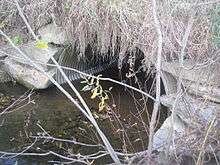
Safe and stable stream crossings can accommodate wildlife and protect stream health while reducing expensive erosion and structural damage. Undersized and poorly placed culverts can cause problems for water quality and aquatic organisms. Poorly designed culverts can degrade water quality via scour and erosion, as well as restrict the movement of aquatic organisms between upstream and downstream habitat. Fish are a common victim in the loss of habitat due to poorly designed crossing structures.
Culverts that offer adequate aquatic organism passage reduce impediments to movement of fish, wildlife, and other aquatic life that require instream passage. These structures are less likely to fail in medium to large scale rain and snow melt events.
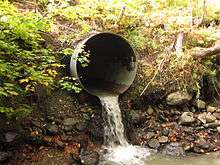
Poorly designed culverts are also more apt to become jammed with sediment and debris during medium to large scale rain events. If the culvert cannot pass the water volume in the stream, then the water may overflow over the road embankment. This may cause significant erosion, ultimately washing out the culvert. The embankment material that is washed away can clog other structures downstream, causing them to fail as well. It can also damage crops and property. A properly sized structure and hard bank armoring can help to alleviate this pressure.
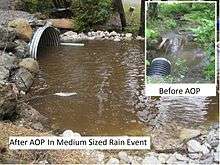
Culvert style replacement is a widespread practice in stream restoration. Long-term benefits of this practice include reduced risk of catastrophic failure and improved fish passage. If best management practices are followed, short-term impacts on the aquatic biology are minimal.[8]
Fish passage
While the culvert discharge capacity derives from hydrological and hydraulic engineering considerations,[9] this results often in large velocities in the barrel, creating some fish passage barrier. Critical culvert parameters in terms of fish passage are the dimensions of the barrel, particularly its length, cross-sectional shape and invert slope. The behavioural response by fish species to culvert dimensions, light conditions and flow turbulence may play a role in their swimming ability and culvert passage rate. There is no simple technical means for ascertain the turbulence characteristics most relevant to fish passage in culverts, but it is understood that the flow turbulence plays a key role in fish behaviour.[10][11] The interactions between swimming fish and vortical structures involve a broad range of relevant length and tine scales.[12] Recent discussions emphasised the role of secondary flow motion, considerations of fish dimensions in relation to the spectrum of turbulence scales, and the beneficial role of turbulent structures provided that fish are able to exploit them.[10][13][14][15][16][17][18] The current literature on culvert fish passage focused mostly on fast-swimming fish species, but a few studies argued for better guidelines for small-bodied fish including juveniles.[15]
Minimum energy loss culverts
.jpg)
In the coastal plains of Queensland (north-east Australia), torrential rains during the wet season place a heavy demand on culverts. The natural slope of the flood plains is often very small and little fall (or head loss) is permissible in the culverts. Professors Gordon R. McKay and Colin J. Apelt developed and patented the design procedure of minimum energy loss (MEL) culverts which yield small afflux. Colin J. Apelt, professor (emeritus) of civil engineering at the University of Queensland, presented an authoritative review of the topic (1983),[19] a documentary video (1994),[20] and a commemorative speech (2011).[21]
A minimum energy loss culvert or waterway is a structure designed with the concept of minimum head loss. The flow in the approach channel is contracted through a streamlined inlet into the barrel where the channel width is minimum, and then it is expanded in a streamlined outlet before being finally released into the downstream natural channel. Both the inlet and outlet must be streamlined to avoid significant form losses. The barrel invert is often lowered to increase the discharge capacity.
The concept of minimum energy loss culverts was developed by Norman Cottman, shire engineer in Victoria (Australia) and by Professor Gordon McKay, University of Queensland (Brisbane, Australia) during the late 1960s.[22] While a number of small-size structures were designed and built in Victoria, some major structures were designed, tested and built in South-East Queensland.
Forestry
In forestry, proper use of cross-drainage culverts can improve water quality while allowing forest operations to continue.
See also
Notes
- ↑ Taylor, Karl (2010). "Thacka Beck Flood Alleviation Scheme, Penrith, Cumbria- Measured Building Survey of Culverts". Oxford Archaeology North.
- 1 2 3 4 Turner-Fairbank Highway research Center (1998). "Hydraulic Design of Highway Culverts" (PDF), Report #FHWA-IP-85-15 U.S. Department of Transportation, Federal Highway Administration, McLean, Virginia.
- ↑ Wild, Thomas C. (2011). "Deculverting: reviewing the evidence on the 'daylighting' and restoration of culverted rivers". Water and Environment Journal. 25: 412–421. doi:10.1111/j.1747-6593.2010.00236.x. Retrieved 2016-04-14.
- 1 2 Alberta Transportation (2004). "DESIGN GUIDELINES FOR BRIDGE SIZE CULVERTS" (PDF), Original Document 1995 Alberta Transportation, Technical Standards Branch, Government of the Province of Alberta
- ↑ Department of Interior Bureau of Land Management (2006). "Culvert Use, Installation, and Sizing" Chapter 8 (PDF), Low Volume Engineering J Chapter 8, blm.gov/bmp.
- ↑ Environmental Protection Agency EPA Management (2003-7-24). "Culverts-Water" NPS Unpaved Roads Chapter 3 (PDF), "CULVERTS" epa.gov.
- 1 2 Architectural Record CEU ENR (2013). "Stormwater Management Options and How They Can Fail" (Online Education Course), McGraw Hill Construction Architectural Record-engineering News Record.
- ↑ Lawrence, J.E., M.R. Cover, C.L. May, and V.H. Resh. (2014). "Replacement of Culvert Styles has Minimal Impact on Benthic Macroinvertebrates in Forested, Mountainous Streams of Northern California". Limnologica. 47: 7–20. doi:10.1016/j.limno.2014.02.002.
- ↑ Chanson, H. (2004). The Hydraulics of Open Channel Flow: An Introduction. Butterworth-Heinemann, 2nd edition, Oxford, UK. ISBN 978 0 7506 5978 9.
- 1 2 Nikora, V.I., Aberle, J., Biggs, B.J.F., Jowett, I.G., Sykes, J.R.E. (2003). "Effects of Fish Size, Time-to-Fatigue and Turbulence on Swimming Performance: a Case Study of Galaxias Maculatus". Journal of Fish Biology. 63: 1365–1382. doi:10.1111/j.1095-8649.2003.00241.x.
- ↑ Wang, H., Chanson, H. (2017). "How a better understanding of Fish-Hydrodynamics Interactions might enhance upstream fish passage in culverts". Civil Engineering Research Report No. CE162: 1–43.
- ↑ Lupandin, A.I. (2005). "Effect of flow turbulence on swimming speed of fish". Biology Bulletin. 32 (5): 461–466. doi:10.1007/s10525-005-0125-z.
- ↑ Papanicolaou, A.N., Talebbeydokhti, N. (2002). "Discussion of Turbulent open-channel flow in circular corrugated culverts". Journal of Hydraulic Engineering, ASCE. 128 (5): 548–549.
- ↑ Plew, D.R., Nikora, V.I., Larne, S.T., Sykes, J.R.E., Cooper, G.G. (2007). "Fish swimming speed variability at constant flow: Galaxias maculatus". New Zealand Journal of Marine and Freshwater Research. 41: 185–195. doi:10.1080/00288330709509907.
- 1 2 Wang, H., Chanson, H., Kern, P., Franklin, C. (2016). "Culvert Hydrodynamics to enhance Upstream Fish Passage: Fish Response to Turbulence". 20th Australasian Fluid Mechanics Conference, Perth, Australia. Paper 682: 1–4.
- ↑ Cabonce, J., Fernando, R., Wang, H., Chanson, H. (2017). Using Triangular Baffles to Facilitate Upstream Fish Passage in Box Culverts: Physical Modelling. Hydraulic Model Report No. CH107/17, School of Civil Engineering, The University of Queensland, Brisbane, Australia, 130 pages. ISBN 978-1-74272-186-6.
- ↑ Wang, H., Chanson, H. (2017). "Baffle Systems to Facilitate Upstream Fish Passage in Standard Box Culverts: How About Fish-Turbulence Interplay?". 37th IAHR World Congress, IAHR & USAINS, Kuala Lumpur, Malaysia. 3: 2586–2595.
- ↑ Wang, H., Chanson, H. (2018). "Modelling Upstream Fish Passage in Standard Box Culverts: Interplay between Turbulence, Fish Kinematics, and Energetics". River Research and Applications. 34 (3): 244–252. doi:10.1002/rra.3245.
- ↑ Apelt, C.J. (1983). "Hydraulics of minimum energy culverts and bridge waterways," Australian Civil Engineering Transactions, CE25 (2) : 89-95. Available on-line at: University of Queensland.
- ↑ Apelt, C.J. (1994). "The Minimum Energy Loss Culvert" (videocassette VHS colour), Dept. of Civil Engineering, University of Queensland, Australia.
- ↑ Apelt, Colin. (2011). "The Minimum Energy Loss Culvert, Redcliffe" (prepared speech: Award of Engineering Heritage National Landmark By Engineering Heritage Australia on 29th June 2011). https://www.engineersaustralia.org.au/sites/default/files/shado/Learned%20Groups/Interest%20Groups/Engineering%20Heritage/EHA%20Queensland/McKay%20Landmark/CJA%20Speech-MEL%20Redcliffe.pdf
- ↑ See:
- CHANSON, H. (2003). "History of Minimum Energy Loss Weirs and Culverts. 1960-2002." Proc. 30th IAHR [The International Association for Hydro-Environment Engineering and Research] Biennial Congress, Thessaloniki, Greece, J. GANOULIS and P. PRINOS, ed.s, vol. E, pp. 379-387. Available on-line at: University of Queensland.
- Chanson, Hubert, Web page: Hydraulics of Minimum Energy Loss (MEL) culverts and bridge waterways.
References
- Oxford English Dictionary, ISBN 0-19-861212-5
- Oxford English Dictionary, ISBN 0-19-861212-5 http://www.fhwa.dot.gov/engineering/hydraulics/pubs/11008/hif11008.pdf
- Fish-friendly waterways and culverts - Integration of hydrodynamics and fish turbulence interplay (2017) The University of Queensland.
External links
- Culvert Technology May Help Young Salmon Muscle Their Way Upstream – Article about the impact of culverts on salmon migration
- Culvert fact sheet – Information produced by Canadian Department of Fisheries and Oceans
- Culvert Analysis Program Graphical User Interface 1.0: A Preprocessing and Postprocessing Tool for Estimating Flow through Culverts United States Geological Survey
- Bottomless Culvert Scour Study – FHWA culvert research
- Design of Road Culverts for Fish Passage Washington Department of Fish and Wildlife guide to designing and constructing fish migration friendly culverts
- More than 50, freely available, published research articles on culvert design, culvert hydraulics and related topics by Professor Hubert Chanson, School of Civil Engineering, University of Queensland
- Hydraulics of Minimum Energy Loss (MEL) culverts and bridge waterways
- Federal Highway Administration Hydraulics Engineering Circular No. 26 First Edition
- Bureau of Land Management Culvert Use, Installation, and Sizing
- Alberta Transportation Technical Standards Branch, Design Guidelines for Bridge Size Culverts
- Upstream fish passage in box culverts: how do fish and turbulence interplay? by Dr Hang Wang and Professor Hubert Chanson, School of Civil Engineering, University of Queensland
